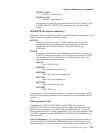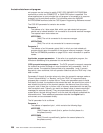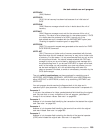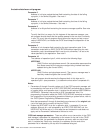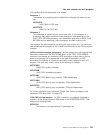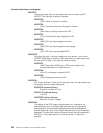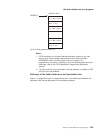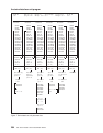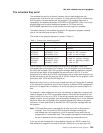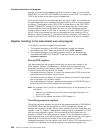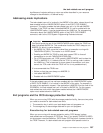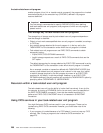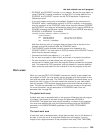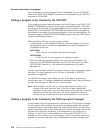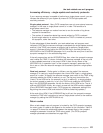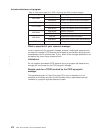
The schedule flag word
The schedule flag word is a fullword indicator that the task-related user exit
program uses to control its own invocation. It is also used by CICS to schedule the
first invocation of a task-related user exit program. The schedule flag word is
accessed by the address parameter UEPFLAGS of DFHUEPAR. There is a unique
schedule flag word for each association between a CICS task and the
ENTRYNAME specified when a task-related user exit program is enabled.
The default setting of the schedule flag word is for application program requests
(that is, the last two bytes are set to X'0004').
The format of the schedule flag word is shown in Table 11.
Table 11. Format of the schedule flag word
Byte Setting Comments
0 — Reserved.
1 — Reserved.
2
UEFDFEDF
UEFDTASK
UEFMFEDF (X'10')
UEFMTASK (X'01')
Bit mask for EDF invocation.
Bit mask for task manager.
3
UEFDSYNC
UEFDAPPL
UEFDSPI
UEFMSYNC (X'10')
UEFMAPPL (X'04')
UEFMSPI (X'02')
Bit mask for syncpoint manager.
Bit mask for application program.
Bit mask for SPI.
The bit settings of the schedule flag word show which programs invoke your
task-related user exit program. For example, if an exit program is to be invoked by
the CICS task manager, the CICS syncpoint manager, and an application program,
then the last two bytes of the schedule flag word are set to X'0114'. If an exit
program is to be called by the CICS task manager and an application program only,
the last two bytes of the flag word are set to X'0104'. Before the exit program is first
called by a task, CICS sets the API flag bit on.
Before returning from any call, the task-related user exit can change the bit settings
of the flag word to register its need to be invoked by a different CICS management
service, or to register lack of interest in a service by setting the relevant flag bit to
zero.
For example, a task-related user exit may be called by an application program that
needs to access a non-CICS recoverable resource. When the exit program is first
called, the API bit is set on by CICS. If the calling program then issues a request to
update a record, the exit program sets the syncpoint manager bit on in the schedule
flag word. When the calling application program subsequently issues a syncpoint
command, or when end-of-task is reached, the CICS syncpoint manager calls the
exit program.
Note: CICS sets the syncpoint manager bit off after every call to the syncpoint
manager. This is to avoid the CICS syncpoint manager invoking the
task-related user exit program for a unit of recovery during which the exit
program did no recoverable work. The syncpoint manager bit must therefore
be set on whenever the exit program performs any recoverable work.
If you set the task manager bit in the schedule flag word on, CICS invokes your
task-related exit program at the end of this task. (Note that, if you want your exit
the task-related user exit program
Chapter 2. Task-related user exit programs 265



